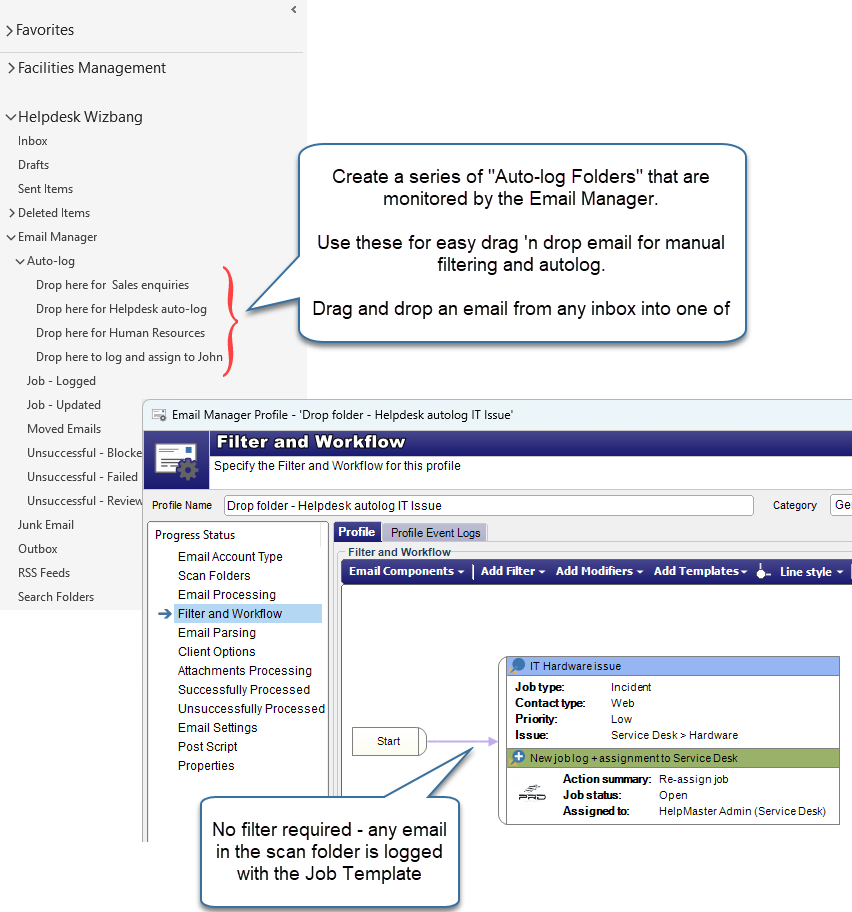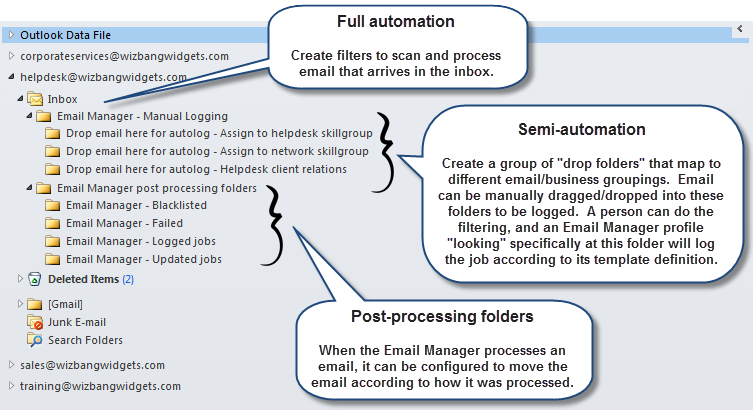Configuring the Email Manager Mailbox Folders
An effective email response system relies on the folder structure of your email environment.
The Mailbox folders of the Email Manager refers to the email folders (or labels if using Gmail) that you create within your email mailboxes to store and manage all of the email that is being processed. Depending on how this is configured and the extent to which you want to automate your email processing, you can create flexible and powerful email processing profiles that can work across multiple email accounts and automation patterns.
It is recommended that this step of email automation is carefully thought-out and planned before going too far into the designing of Email Manager profiles. The folders (labels) you create and the structure in which you create them may affect all of the Email Manager profiles that you use. The structure of the mailbox folders can also determine whether your email response management operations are fully automated, partially automated, or a hybrid of both.
Scan folders
Scan folders refer to the email folders that the Email Manager will scan when looking for new email to process. Each Email Manager profile that you create will require at least 1 scan folder. If using an Outlook profile as the email source, the profile can scan multiple email locations. This may be a combination of Inboxes, or other email folder locations, including public folders, and specially created scan folders - see below.
Any other email source including, Microsoft 365, Google Workspace account, or Internet email (legacy IMAP), can only scan folders from a single selected mailbox.
Scanning the Inbox
The most common location for scanning an email account is usually the Inbox of the email account(s) that you are monitoring. This is where new email is automatically delivered for all email types. You simply point the Email Manager profile to the Inbox of the account you’re scanning. When scanning the Inbox of an email account, it is common to use a series of subject and message filters to match incoming email to the right job template so that the right type of email gets logged in the appropriate way.
Scanning other folders by creating custom drop email here folders
An alternative, and common practice when using the HelpMaster Email Manager is to configure a series of custom email folders within your email system that staff can use to manually drag ’n drop email from the inbox into. By doing this, you are effectively creating a set of scan folders that allow a human to do the filtering, and then the HelpMaster Email Manager to log the job. This can be a very effective way of managing a busy inbox. This is often desirable because it may not be possible to create a set of filter logic that successfully catches all of the email of a particular type. By using a human to move email, based on their review of the email, an Email Manager profile simply scans a particular folder waiting for new email to appear (moved into), where it will convert it into a HelpMaster job via a dedicated template.

Some examples of scan folders might be….
- A folder that relates to specific issues. Match this folder to a profile that logs jobs based on a specific job template. You may wish to create several folders of this type to allow for different types of job templates
- A folder that is used to assign jobs to specific staff members. Match this folder to a profile that always assigns to a specific person. You may wish to create several folders of this type to allow quick and easy job logging and assignment. Jobs may be logged with generic properties, that can later be updated. See Undefined System Codes
- ..or just a “Log everything / Catch-all” folder that will convert the email into a job using a generic Job Template.
Use a combination
Of course, it’s also possible to use a combination of these two methods and approaches, and this is very common.
Use the inbox filtering to catch and process email that can be easily filtered.
Use scan folders to process email that may require initial sorting and filtering that is performed by someone who monitors the inbox and can move email to appropriate folders.

Post-processing folders
Post processing folders are used to store email once it has been processed by the Email Manager. Once the Email Manager processes an email, it has the ability to move or delete the original incoming email, based on the rules that you set. In order to facilitate these post-processing actions, it is recommended that you create a number of new email folders. These folders will help you to manage and keep track of processed email.
These folders can be created as subfolders of your inbox, or in other areas of your profile. For information on how to create email folders within your mail system, please refer to the help file for your email system, or contact your system administrator. It is recommended that you manually create at least the following 3 folders within your email system.
Email Manager : Logged emails
You can configure the Email Manager to move the original email to this folder whenever a new job is logged for the email.
Email Manager : Actions added to existing job
You can configure the Email Manager to move the original email to this folder whenever a job is updated for the email.
Email Manager : Failed emails
You can configure the Email Manager to move the original email to this folder whenever a processing error occurs for the email
Adopt a naming convention for your folders
A good practice in this configuration step is to choose meaningful names for your working folders. Make them somewhat description of the intention of the folder. Make good use of the hierarchical nature of folders. Remember that the Email Manager can scan any folder, regardless of where it is. It it not restricted to just processing an Inbox.
Incoming email that is the result of a person responding to an existing job, will arrive in the Inbox and should be automatically processed via an Update style Email Manager profile. See Updating existing jobs
See Also
Specifying which folders to scan
Post processing options - Handling the original email
Feedback
Was this page helpful?
Glad to hear it! Please tell us how we can improve.
Sorry to hear that. Please tell us how we can improve.